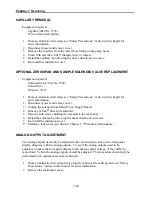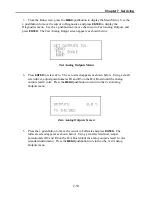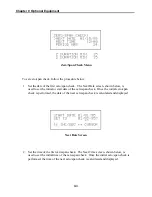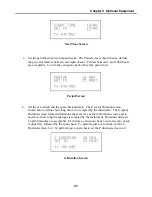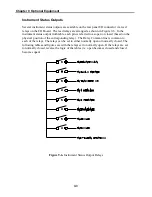
Chapter 8 Theory of Operation
Detector and Preamplifier
The detector used on the Model 48C is a Photo Conductive, Lead-Selenide (PbSe)
device, with an internal thermoelectric cooler. The PbSe detector operates through use of
the internal photoelectric effect.
That is, its conductivity is proportional to the high intensity hitting it. One characteristic
of this device is that it has a high conductivity even with no light. The background
conductivity increases with increasing temperature. Thus in order to reduce the
background conductivity, the detector is cooled. In order to distinguish the signal from
background, the source is chopped. Thus the output of the detector includes an ac
component due to the light signal, superimposed upon a dc component due to the
background conductivity. It should be noted that the ac component is very small
compared to the dc component.
The output of the detector passes through a coupling capacitor C2 and C3 of the
preamplifier board, which only passes the ac component. The ac component is then
amplified by the op-amp IC-1. The output signal is an ac signal, with a low frequency
component and a high frequency component. The low frequency component is at 30 Hz,
and is due to the 30 Hz rotation of the correlation wheel. The high frequency component
is at 360 Hz and is due to the mask on the correlation wheel which divides the wheel into
12 sectors. The output of the preamplifier is fed through a shielded cable to the input
signal conditioning board.
Input Signal Conditioning Board
The Input Signal Conditioning Board contains the circuitry necessary to operate the AGC
(automatic gain control), the rectifier, and the demodulation circuitry. In addition, it
includes the necessary components to digitize the signal output.
The output of the detector is fed to U1, which acts as a control gain amplifier. The
control sensing element for the AGC feedback is the resistor RAY1, acting with U1 to
feedback the gain information to the control gain amplifier.
The output of the control gain amplifier passes through a buffer. This information is then
fed to D4, D5, and U4 for demodulation. This signal is digitized by use of the V-F's U12,
U13, and U14.
8-2
Summary of Contents for 48C
Page 4: ......
Page 12: ......
Page 14: ......
Page 18: ......
Page 27: ...Chapter 3 Operation 3 3 Figure 3 2 Flowchart of Menu Driven Software ...
Page 112: ......
Page 116: ......
Page 120: ......
Page 123: ...Chapter 7 Servicing 7 3 Figure 7 2 Model 48C Component Layout 48P737 ...
Page 125: ...Chapter 7 Servicing 7 5 Figure 7 3 Optical Bench Exploded View 42P761 ...
Page 138: ......
Page 146: ...Chapter 9 Optional Equipment 9 2 Figure 9 2 Model 48C Dimensional Outline D42P725 ...
Page 155: ...Chapter 9 Optional Equipment Figure 9 8 Purge Housing Assembly 9 11 ...
Page 158: ......
Page 178: ...Appendix B RS 232 Commands B 20 µ ...
Page 184: ......
Page 186: ...C 2 ...
Page 187: ...C 3 ...
Page 188: ...C 4 ...
Page 189: ...C 5 ...
Page 190: ...C 6 ...
Page 191: ...C 7 ...
Page 192: ...C 8 ...
Page 193: ...C 9 ...
Page 194: ...C 10 ...
Page 195: ...C 11 ...
Page 196: ...C 12 ...
Page 197: ...C 13 ...
Page 198: ...C 14 ...
Page 199: ...C 15 ...
Page 200: ......
Page 201: ...APPENDIX D PUMP MAINTENANCE ...
Page 202: ......
Page 203: ......
Page 204: ......







